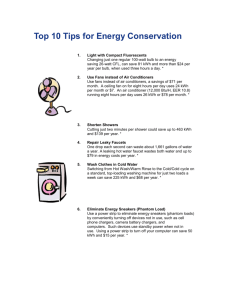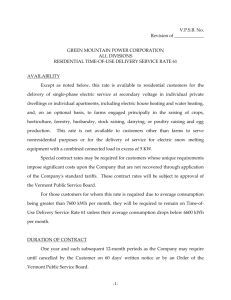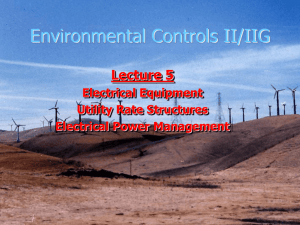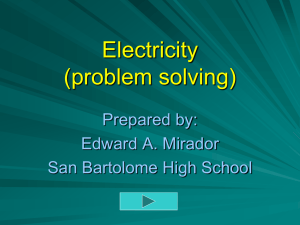Electrical Billing and Rates
advertisement
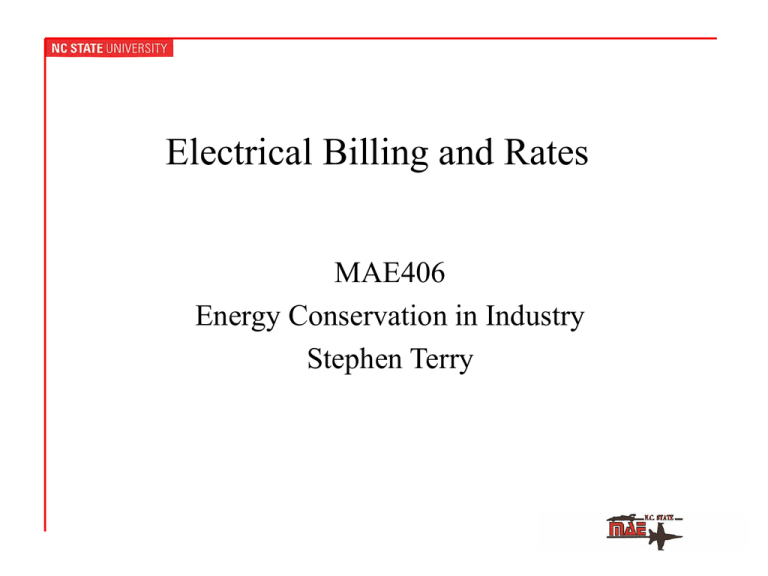
Electrical Billing and Rates MAE406 Energy Conservation in Industry Stephen Terry Where Does Electricity for Industrial Plants Come From? • Most from Investor Owned Utilities (IOU’s) like CP&L and Duke Power • Electricities and NC Co-ops in small towns and rural locations • May be generated on-site in Combined Heat and Power CHP) applications How is Electricity Generated? • Nuclear plants are baseloaded since they are cheap to operate and need long hours to pay back initial investment • Coal / Oil / Gas Boilers – moderate cost • Natural Gas Turbines – expensive to operate, used only for peak use Power vs. Energy • Power is a rate quantity - 1 kW = 1 kJ/sec • Energy is measured using kJ or kWh Note: 1 kWh = 1 kJ-hr/sec = 3,600 kJ Energy = Power d (time) Parts of an Electric Bill • Service Charge: Constant regardless of electrical energy use. Typically between $5 and $500 per month • Energy Charge: charge based on amount of energy (kWh) used • Demand Charge: charge based on highest power required during interval • Taxes, Rebates, and Other Charges Residential Bill • Small service charge: for CP&L = $6.75 • Energy Charge: about $0.095/kWh for energy used in the summer and $0.085/kWh for winter. • Demand Charge: does not apply since household is small user • Taxes, Rebates: varies with user Commercial / Industrial Billing • Industrial plants can use 1,000 kW or more of power. • Power company must build capacity to meet the maximum load, even if it is used only a few hours per day air conditioners in the summer. • Peak loads occur infrequently and must be met with expensive generation equipment (i.e., gas turbines), which increases cost to generate power. Demand Intervals 1200 Power, kW 1000 800 600 400 200 0 12:00 AM 4:00 AM 8:00 AM 12:00 PM hour of day 4:00 PM 8:00 PM Billing Demand • The demand interval is usually 15, 30, or 60 minutes (see rate schedule). • The maximum value of the power for all intervals in a month is the peak demand. • Billing demand = peak demand, unless it is well below historical peaks or contract demand. Demand Ratchet Clause • Some older rate schedules specify that the billing demand is the maximum actual demand for the last 12 months. • It can also be either the current month’s peak demand or 80% of the contract demand. • This is so power companies can recoup investment in power generators. Industrial Electric Bill Based on rates from CP&L Large General Service 97 rate for a typical industrial plant energy and demand usage. Charge Type Usage Rate Service Charge $500.00 Energy 350,000 kWh $0.036335 $12,722.50 Demand 1,000 kW $11.25 $11,250.00 Taxes Total 3% of bill $734.18 $25,206.68 Time of Use Rates • It’s more expensive to make power during the day when everyone wants it rather than at night. • Time of Use rate rewards customer using power at night with lower rates at night. However, rates during the day (on-peak) and the peak demand rate is usually higher. Time of Use Rate Example 1200 Power, kW 1000 800 600 400 200 0 12:00 AM 4:00 AM 8:00 AM 12:00 PM hour of day 4:00 PM 8:00 PM TOU Example cont’d • Energy used in the blue shading is charged at onpeak rates ($0.03048/kWh for CP&L Rate 97) • Energy used in the red shading is charged at offpeak rates ($0.02548/kWh) • On-peak times are for non-holiday weekdays. Weekends / holidays are off-peak • Billing demand is determined to be maximum power used during any on-peak interval Sample Bill – TOU Rate Charge Type Usage Rate Service Charge $500.00 On-peak Energy 150,000 kWh $0.03048 $4,572.00 Off-peak Energy 200,000 kWh $0.02548 $5,096.00 Demand (summer) 1,000 kW $19.56 $19,560.00 Taxes Total 3% of bill $891.84 $30,619.84 Notes: • TOU bill is more in this case. What is usage factor (is this a 1, 2, or 3 shift plant?) Usage Factor = kWh / kW demand = 350,000 kWh/ 1,000 kW = 350 hrs/month = 16 hrs/day Plant probably operates two full shifts, maybe three shifts – with lower production at night. Notes: • Time of use benefits companies that work seven days per week and manufacture at night. • Costs can be reduced by scheduling operations around peak periods – load shifting. • Costs can be reduced by utilizing thermal storage for HVAC system and operating equipment during off-peak periods. Other Types of Rates • Tiered Rate: Example: Energy Charge – First 10,000 kWh $0.05/kWh Next 25,000 kWh $0.04/kWh Above 35,000 kWh $0.03/kWh Plant using 100,000 kWh would have an energy charge of $3,450 or $0.0345/kWh Duke Rate I • Double tiered schedule based on ratio of kWh/kW demand, then sub-tiered based on energy usage within kWh/kW tier. • These rates are difficult to compute, but generally reward companies that operate more hours and have flatter power profiles. Average Energy Charge • Many plants will use an average energy rate in evaluating projects, which includes energy and demand costs. • This is not accurate since equipment affected may not operate all of the time. “Average” Errors • Example 1: Turn lights off at night. For a time of use rate, what is proper energy charge if lights are turned off at 11 pm and back on at 6 am? How about demand? • Example 2: Adding a new air conditioner to handle peak cooling. When does unit operate and what is energy cost? How about demand? Power Factor • Some utilities will charge for power factor. • Power factor is the phenomenon of peak current draw being out of phase with peak voltage draw. • This causes the power company to have to supply more power than is registered on the meter. • Major causes electric motors that draw current for magnetizing the windings (inductive loads) Power Factor • Solution: install capacitors to offset inductive loads • Check to see if you’re charged for power factor first, most NC companies aren’t! Other Charges • Fuel Riders – let power company adjust for highly varying prices for their fuel • Facilities Charges – extra equipment installed onsite, like a larger transformer or power fed from two separate lines for redundancy. Deregulation • Over the past 15 years, some state have deregulated electrical power. • This means that billing for the three basic components are separate and users may choose their own suppliers: Generation Transmission Distribution Deregulation • Virginia has partially deregulated its markets and will fully deregulate in 2010. • NC has no plans to deregulate anytime soon • Experience has shown that most people see an increase in costs with deregulation because companies must compete with high cost of electricity to places like California. Conclusions • Most power companies bill energy and demand. • It is important to know your rate, on-peak hours and all costs. • Use proper energy and demand rates for computing energy costs and savings.


